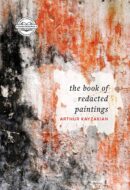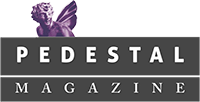 The Book of Redacted Paintings
The Book of Redacted Paintings
Arthur Kayzakian
Black Lawrence Press
Reviewer: Lee Rossi
In a recent interview in the New York Review of Books, poet and critic Ange Mlinko comments on the recent glut of “project” books (a genre I’ve come to call “term paper poetry”). She notes that publishers are striving “to make books of poetry more like prose books … books with selling points, books that are marketable, and perhaps, ultimately, books that can be hashtagged. It also dovetails with a market that wants poetry to document crises, take moral stances on social issues, and clearly answer the question, ‘What’s the takeaway?’ The project book is perfect for an audience trained on journalism and memoir.” The result is volume after volume that resists the challenges of language and insight.
The story of Armenian-American poet Arthur Kayzakian’s The Book of Redacted Paintings is fairly straightforward; in his “artist’s statement” (available on his publisher’s website) Kayzakian sketches the following plot: “The narrative arc is about a boy in search of his father’s painting, but it is unclear whether the painting exists or not.” Eventually he comes to realize that the painting never existed, that what existed was the trauma of his father’s disappearance, the circumstances of which he hints at in the following phrases: “the blast, the knock on the door, the shuffle of feet” (from “Just Because My Father Was Never Painted Doesn’t Mean the Painting Doesn’t Exist”). Was the father disappeared (like so many others during the reign of the Shah and the rule of the Mullahs)? Did he abandon the family?
I’m unable to say, on the basis of what I find in the book. Why the reticence? Surely the writer and/or the members of his extended family know the truth. Why does he withhold the truth from his reader? Does it have something to do with his various addictions (drugs, alcohol)? Is it the objective correlative of PTSD? Or does it reflect a kind of unwillingness on the part of the author to bow to the demands of the market? I wish I knew, even as I admit that I just don’t know.
This is not to say that many of the pieces, taken on their own, are not charming, compelling, or at least intriguing. In telling his story, Kayzakian employs a variety of formal strategies: concrete poetry, police reports, fake letters from art dealers and historians, plus lots and lots of densely imagistic surrealism.
“The Toast,” for instance, is a macabre twice-told tale evoking the Armenian genocide. A boy is kidnapped by a group of “soldiers in green uniforms,” one of whom returns later, saying to the boy’s younger sister, “I have a gift for you.”
Then [he] held a skull in front of her
and blew over the right eye socket.
Out droned a low hum
like the inside of a seashell,
the guard looked up with a smirk—
I’ve made a flute for you.
Given that scenario, one might remember Carolyn Forché’s “The Colonel,” but similarities aside, the circumstance of the soldier taunting a child makes this anecdote even more horrific than Forché’s.
Another noteworthy piece, “Questions Truth and Lies on Art Trauma,” demonstrates Kayzakian’s gift for epigram. Here’s one quip: “Have you ever felt so censored that you’ve seen your face on a milk carton in your dreams?” Here’s another, which comments obliquely on the project of this book: “Ekphrasis may be the translation of artwork to poems, but the best translation of darkness is a victory flag.”
As with the epigrams, Kayzakian’s book offers a kaleidoscope of viewpoints, anecdotes, and images. Wholeness is a concept, one of those Platonic Ideas whose realization is seldom if ever achieved. Kayzakian’s central image, his father, is a jumble of tesserae assembled from different eras and loci of the poet’s imagination. Sometimes the pieces almost cohere, but on the whole what we’re viewing is Cubist portraiture.
The book begins with a memory wreathed in tenderness (from the poem “home”):
The night I kissed my father on his cheek,
his smile,
glazed with the scent of smoke and bravado,
softened.
Not even silence has a name for that.
Notice the languorous pace, but also the equivocation, how the father’s very masculine smile, “glazed with … smoke and bravado,” softens. Later we learn that the father keeps his tenderness hidden from the boy and presumably the rest of the family. In “Reading with My Father” the poet remembers that “after reading to me each night, / [my father] loved to shut his door, turn off the lights // and sing to himself.”
In another anecdote, what the poet remembers is the father’s cruelty. Trying to explain her black eye, the mother says, “It is the astronomy of the hand best seen through cause and effect . . . // She was scientific about it, touching the solar system pulsing around her eye.” Like the Sultan, like the Shah, the father rules with an iron hand; and yet the poet cannot simply renounce his patriarchal heritage, as he tells us in “When We Fled Iran”:
this morning i pray
for the back of my father’s hand
a map to manhood
across my face
Of course, I may be reading too much into these whispers and asides. After all, we have been overwhelmed in the last couple of decades with narratives of domestic violence. But what about all those years we were staring abuse in the face and refusing to call it by its proper name?
Yet the poet and his family were not the only victims of abuse. Far from it. Neighbors were disappearing, as were whole communities. Uprooting and flight did nothing more than postpone yet another reckoning with prejudice and hatred. One of the book’s most interesting moves, one which defies narrative logic, is the introduction of the Armenian-American painter, Arshile Gorky, who seems almost a surrogate father. Gorky committed suicide by hanging himself in his studio.
Even stranger is the inclusion of Anna Walinska, a painter, teacher, and activist working on behalf of Jewish causes. In “Anna Walinska” the poet writes: “It was raining the night Anna Walinska sold her portrait to make rent. Nobody wanted to buy the painting by Arshile Gorky, so the price was low.” All that was left was a blank space on the wall, “the shape of something absent,” like the absence of the poet’s father. Did the poet know Walinska? Had he seen that empty space? Had he simply read about it and been so impressed that it flooded his imagination with emptiness? Reader, this is poetry—your guess is as good as mine.

